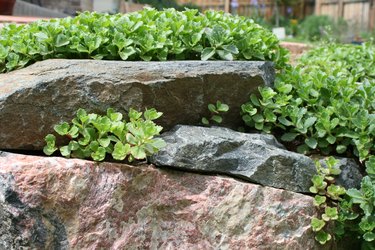Rock landscaping ideas transform your outdoor area into a beautiful and functional space. Stone is a natural fit in the landscape, serving to complement and balance the ever-changing nature of the living trees, shrubs, garden plants and lawns that make up a yard's softscape.
As a hardscape building material, rock has undeniable virtues. Available in a huge range of sizes, colors, patterns and textures, stone is perhaps the most durable building material you can use, and it may well outlast every other building material in your home.
Video of the Day
Video of the Day
Rock Landscaping Ideas: Choosing Stone
The secret to effective design with stone is to use indigenous stone products native to the area, and to use them in the landscape in a manner that seems natural for the geographic region. For example, in the desert Southwest, red sandstones are a natural choice for a paving material, while in the far Northeast, the same patio space will look natural if paved with slabs of the granite that is so prevalent. In the bluff country of the Midwest, on the other hand, a terraced retaining wall garden made of large slabs of limestone mined from the local hills will lend a feeling of natural familiarity to a home landscape.
The style of the home can also dictate the type of stone. A residence that has an authentic Italian villa style can effectively use marble, which might be ill-suited to a traditional ranch-style rambler.
Pathways and Patios Paving Surface
Natural stone in cut tiles or thin slabs makes one of the more elegant and premium paving surfaces available for patios or pathways. Natural stone brings class to your landscape in a way that brick or decorative concrete can't approach.
Cut stones or thin slabs can also be used for cobblestone pathways. For a more rustic pathway, use finer gravels, possibly with larger stones for the borders. A rustic stone or gravel pathway is best designed with winding, natural flow. Use the stone pathway to lead guests to different garden areas or to a seating area away from the house.
Stairways and Garden Steps
Garden steps are given a big touch of elegance when they are made from natural stone, such as large pieces of cut limestone or granite mortared together. More rustic steps can be formed with raw flat stones placed to approximate the position of more formal stairs.
Garden stairs are best designed with steps that are broad and wide, but relatively short in height. Where possible, the choice of stone should echo materials found elsewhere in the landscape. For example, if a patio is constructed of limestone flagstones, use thicker limestone slabs in a similar color and texture for the garden steps.
Terraces and Retaining Walls
Slabs of cut limestone, granite or other hard stone make excellent retaining walls and landscape terraces. Installed correctly with careful engineering and installation, a stone retaining wall will outlast any wall made of timbers, concrete block or even poured concrete.
A terraced retaining wall is very labor-intensive to construct, and proper drainage is critical to its long life. Stone walls can be dry-set without mortar, or installed with mortar filling the joints.
Rock Garden Walls
As with retaining walls, natural stone also makes a great building material for freestanding garden walls. Here, it's especially useful to build with stone that is native to your area, both because of cost, and because walls built with native stone will look much more natural.
In New England, for example, the classic colonial garden walls were generally built from the many tons of stone cleared from agricultural fields. To this day, that's a style that looks most consistent. In the Midwest, it was small rounded boulders, smoothed and hewn by glacial action, that became the prime building material for landscape walls. In the desert Southwest, red sandstones are a good choice for stone garden walls.
Garden Mulch Material
The use of raw gravel and weathered beach stone as a mulch material to cover the ground beneath beds of shrubs and landscape plants was all the rage for some time, although now many homeowners are digging out that gravel to replace it with a more aesthetically pleasing organic groundcover mulch or even with living groundcover plants.
Still, there is a perfectly good role for smaller aggregate stone in some applications, such as in a region where the prevalence of streams or rocky beaches make beds of gravel in a landscape seem like a natural extension of nature. River rock also makes a good groundcover for a rain garden.
Decorative Water Features
Natural stone boulders and rocks can form the heart of a custom-built fountain or pond structure, or they can be used to dress up and accent prefabricated ponds. Achieving a natural look is no easy matter with a stone water feature, and homeowners may want to consult a professional designer to create such a look. It generally requires a considerable amount of earth-moving.
Commercial fountains and bubblers made from carved and bored stone with small water pumps are also available, providing all the appeal of a stone water feature in a manageable size.
Decorative Rock Gardens
A rock garden creates a focal point in the landscape and can be built to just about any scale you want — from fine gravel used as a bed for desert succulents to piles of boulders with ornamental specimens planted in every crevice and crack. Some rock gardens don't even include plants at all but are simply collections of various types and sizes of rock, which often form the backdrop for plantings.
Certain types of gardening themes are better suited than others to the use of rock gardens, such as desert gardens, alpine gardens and Japanese gardens. Rock gardens are especially appropriate on sloped landscape sites, but they can also be used simply to add a focal point to an otherwise mundane landscape.
